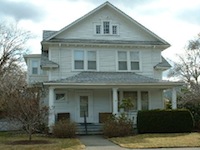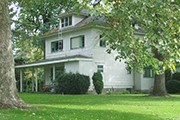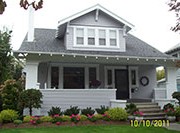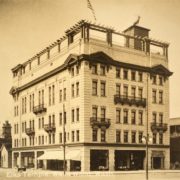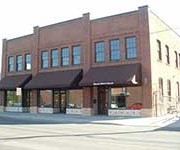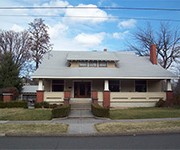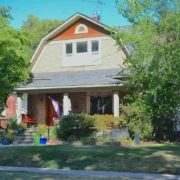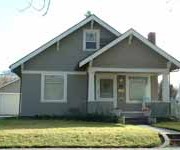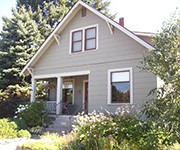History of 716 University Street, Walla Walla, WA
Legal Description
East 31 feet in width of Lot 5 and the West 29 feet in width of Lot 4 in Block 2 of Isaacs’ Park Addition, according to the plat recorded in volume “C” of plats at page 37; TOGETHER with and subject to an easement for the common driveway over the easterly 4 feet 4 inches of the westerly 19 feet of said Lot 5, and over the westerly 32 inches of the east 31 feet of Lot 5 in said Block 2 of Isaacs’ Park Addition, as established by instrument recorded under auditor’s file No. 447557.
Title History
Walla Walla was originally laid out by surveyor H.H. Case in 1859, even before its formal incorporation as a city in 1862, as a one quarter mile square oriented N-S, E-W with its eastern side centered on the point where Main Street crossed Mill Creek (at roughly where it does now). To this original area additional parcels were annexed from time to time, usually bearing the name of the landowner of record at the time the additions were made. 716 University is located in Isaacs Park Addition, one of the several additions developed by Henry P. Isaacs and Lucie Isaacs in the center part of Walla Walla, as shown in the 1909 City Atlas.
The first recorded transaction involving 716 University was on May 23, 1863 when John Haley sold “all that portion of the SW ? of section no. 21 in Township no. 7, County of Washington, Washington Territory” which was 26.81 acres “more or less” for “consideration $100.” The buyers were William H. Patten and Elizabeth A. Patten. Shortly thereafter on January 20, 1864 the Pattens sold the parcel to Henry P. Isaacs for $2000 in gold coin. On April 6, 1866 a larger section of 80 acres (which seems to have included the previous 26 acres) was sold by the Pattens to the Isaacs for an additional $2000. This transaction reappears on November 22, 1901 when the heirs of the Pattens and Isaacs dealt with an error in the description of the land and a “fatal defect” in the deed. Elizabeth Patten had not signed the deed. It had only been signed by her husband, W.H. Patten. This was corrected and records show that for $1.00 the heirs of the Pattens filed a quit-claim to the heirs of the Isaacs.
Isaacs was influential in the development of Walla Walla as a wheat growing area. Lyman in his History of Walla Walla County states that Isaacs “demonstrated to the farmers that wheat could be produced profitably on the hills and uplands which in those early days had been given over to stock-raising.” Isaacs built numerous flour mills throughout the Northwest and “his knowledge of the manufacture and handling of flour became proverbial and he was recognized as an authority on all matters pertaining thereto.” He found markets for wheat in the Orient, especially China. The Isaacs and their son J.C. Isaacs also founded the Walla Walla Water Company, providing Walla with a reservoir, ditches, conduits and the possibility of irrigation of crops. The right to utilize “subterranean” water is included in documents in 1886 and 1896 pertaining to what would become 716 University. The Isaacs built the Queen Anne style home located at 100 Brookside Drive.
Henry Isaacs died in 1900 with no will which left his heirs to deal with his numerous properties. On July 6, 1903 the Isaacs heirs formed the H.P. Isaacs Company and the development of Isaacs Park Addition began with the division of lots. The first recorded sale pertaining to 716 University occurred when the H.P. Isaacs Company sold what were then two parcels in Block 2 to Mabel and Sylvester Scott on December 4, 1907. The Scotts then divided Block 2 into 14 lots of varying sizes. Half of these lots (8-14) face Pearson St. and the other half (1-7) face University St. The lot that 716 University sits on is portions of lots 4 and 5 as stated in the Legal Description. The Scotts stipulated that construction of houses on these properties had to cost no less than $1500, a fairly hefty sum in that era. Only one house per lot would be permitted.
On April 20, 1908 the Scotts sold the lot that 716 University sits on today to William P. and Bessie FitzJerrell for $1000. On August 6, 1908 a Building Permit (#206) was issued to W.P. FitzJerrell for “a two story frame cottage” which was estimated to cost $3900. The builder was listed as J.A. McLean. In the 1909-10 City Directory, William FitzJerrell was employed at Walla Walla Paper and Stationary Company, which was located at the corner of First and Alder in the Ransom Building. In the 1911-12 City Directory, William and Bessie FitzJerrell were listed as grocers at the Good Things to Eat Market located at 1067 Isaacs. The 1914 City Directory gives their address as the grocery store indicating that they no longer resided at 716 University. There is no evidence of what their living quarters might have been since the building has been remodeled and now houses the Walla Walla Community Hospice.
There were no identifiable listings of residents at 716 University in city directories from 1914-1921 although an indenture was filed on November 29, 1910 indicating that the house was owned by B.F. Culp and Rebecca Culp. There was no indication that the Culps were ever residents of 716 University. Apparently the house was a rental until it was sold to Frank L. and Jauanta R. Shannon for $7600 on October 15, 1920. The Shannons are listed in the 1923-24 Directory as residing at 325 Alder. On January 24, 1924 the Shannons sold the house to F.B. Clark, a widower, who experienced financial problems. On April 14, 1925 the house was purchased from Central Finance Co. by Ralph and Alma Glafke for an undisclosed amount. City Directories show that the Glafkes had resided at Clinton Court Apartments for several years preceding their residency at 716 University. The 1931-32 City Directory lists Ralph Glafke as the President and Manager of Interior Grocery Store. On July 7, 1941 the Glafkes sold the house to Sid B. and Birdie Harman for an undisclosed amount. The Harmans owned Recreation Bowling Alleys according to the 1941 City Directory and resided at the house until 1954. The house appears to have been a rental until 1956 when it was purchased by Carroll B. Adams and Marjorie R. Adams for an unstated amount. Carroll Adams was President and General Manager of Adams Tractor Company. The Adams resided at 716 University until 1974 when Francis John Trapani and Sonia Louise Trapani bought the house for $32,500. The Trapanis seem to have lived at the house for only a year. Dr. Trapani was a chiropractor for 30 years with an office at 1618 Isaacs. His son Stephen Trapani is listed in the current Yellow Pages as taking over the business.
On February 10, 1975 Francis John Trapani and Sonia Louise Trapani sold the house to William W. Fogg and Joyce E. Fogg for $32,500. William Fogg was Division Manager of Western Farm Service. Joyce Fogg was employed as an English as a Second Language Instructor and later as the Director of Transitional Studies at Walla Walla Community College from 1976-2007. A Quit Claim Deed was filed by William Fogg on behalf of Joyce Fogg in the settlement of the dissolution of their marriage in 1999.
The shared driveway is an unusual situation which was included in the deed for the property sale. The property next door on the west side of 716 University shares the same driveway. There is an alley on the south side of the property but neither of the garages are accessed by it.
Construction of the House
Documents in the Walla Walla Assessor’s Office gives 1906 as the construction date for 716 University. This 1906 date turns out to be incorrect. Research shows that the Building Permit for construction of this house was issued on August 6, 1908. This seems to be early enough in 1908 to finish the house during that year. The builder of the house was J.A. McLean. The owners were William and Bessie FitzJerrell who lived in the house probably until 1914.
Resources used for this research:
Penrose Library Northwest Archives files, Whitman College
Pioneer Title Company documents for this property
Sanborn Fire Maps, 1894-1938
A Visit to the House
Walla Walla City Directories
Katherine H. Weingart Walla Walla 2020 Historical Research P.O. Box 1222 Walla Walla, WA 99362 November, 2009
